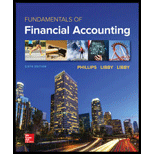
Determining Financial Effects of Transactions Affecting Current Liabilities with Evaluation of Effects on the Debt-to-Assets Ratio
EZ Curb Company completed the following transactions. The annual accounting period ends December 31.
| Jan. 8 | Purchased merchandise on account at a cost of $14,000. (Assume a perpetual inventory system.) |
| 17 | Paid for the January 8 purchase. |
| Apr. 1 | Received $40.000 from National Bank after signing a 12-month. 6 percent, promissory note. |
| June 3 | Purchased merchandise on account at a cost of $18,000. |
| July 5 | Paid for the June 3 purchase. |
| Aug. 1 | Rented out a small office in a building owned by EZ Curb Company and collected six months’ rent in advance, amounting to $6,000. (Use an account called Unearned Revenue.) |
| Dec. 20 | Collected $100 cash on account from a customer. |
| Dec. 31 | Determined that wages of $6,500 were earned but not yet paid on December 31 (ignore payroll taxes). |
| Dec. 31 | Adjusted the accounts at year-end, relating to interest. |
| Dec. 31 | Adjusted the accounts at year-end, relating to rent. |
Required:
- 1. For each listed transaction and related
adjusting entry , indicate the accounts, amounts, and effects (+ for increase, − for decrease, and NE for no effect) on theaccounting equation , using the following format:

- 2. For each transaction and related adjusting entry, state whether the debt-to-assets ratio is increased or decreased or there is no change. (Assume EZ Curb Company’s debt-to-assets ratio has always been less than 1.0.)
1.
To show: Accounting equation effect for the given transactions.
Explanation of Solution
Liabilities: Liabilities are debt and obligations of a business. These are the claims against the resources that a business owes to outsiders of the company. Liabilities may be Current liabilities, and Long-term liabilities. Examples:Creditors, Bills payable, Bank overdraft, Salaries and wages payable, and Notes payable.
Accounting equation effect:
The following is the accounting equation for the given transactions:
Working note:
Calculate interest expense at December 31 as below:
Calculate the amount of unearned revenue earned at December 31 as below:
2.
To analyze: The impact of each transaction on debt to assets ratio.
Explanation of Solution
Debt to assets ratio: Debt to assets ratio is used to evaluate the relationship between the total liabilities and total assets of the company. Debt to equity ratio helps the company to determine the proportion of debt and assets. When the ratio is greater than 1, then it is higher and thus, company faces higher risk.
Debt to assets ratio is calculated by using the following formula:
Show the impact of each transaction on debt to assets ratio.
| Impact of each transaction on debt to assets ratio | |||
| Transaction | Total liabilities | Total assets | Effect on Ratio |
| January 8 | Increased | Increased | Increased |
| January 17 | Decreased | Decreased | Decreased |
| April 1 | Increased | Increased | Increased |
| June 3 | Increased | Increased | Increased |
| July 5 | Decreased | Decreased | Decreased |
| August 1 | Increased | Increased | Increased |
| December 20 | NE | NE | NE |
| December 31 | Increased | No Change | Increased |
| December 31 | Increased | No Change | Increased |
| December 31 | Decreased | No Change | Decreased |
Table (1)
Want to see more full solutions like this?
Chapter 10 Solutions
Fundamentals Of Financial Accounting
- Century 21 Accounting Multicolumn JournalAccountingISBN:9781337679503Author:GilbertsonPublisher:Cengage
 Intermediate Accounting: Reporting And AnalysisAccountingISBN:9781337788281Author:James M. Wahlen, Jefferson P. Jones, Donald PagachPublisher:Cengage Learning
Intermediate Accounting: Reporting And AnalysisAccountingISBN:9781337788281Author:James M. Wahlen, Jefferson P. Jones, Donald PagachPublisher:Cengage Learning  College Accounting, Chapters 1-27 (New in Account...AccountingISBN:9781305666160Author:James A. Heintz, Robert W. ParryPublisher:Cengage Learning
College Accounting, Chapters 1-27 (New in Account...AccountingISBN:9781305666160Author:James A. Heintz, Robert W. ParryPublisher:Cengage Learning Financial AccountingAccountingISBN:9781337272124Author:Carl Warren, James M. Reeve, Jonathan DuchacPublisher:Cengage LearningPrinciples of Accounting Volume 1AccountingISBN:9781947172685Author:OpenStaxPublisher:OpenStax College
Financial AccountingAccountingISBN:9781337272124Author:Carl Warren, James M. Reeve, Jonathan DuchacPublisher:Cengage LearningPrinciples of Accounting Volume 1AccountingISBN:9781947172685Author:OpenStaxPublisher:OpenStax College





